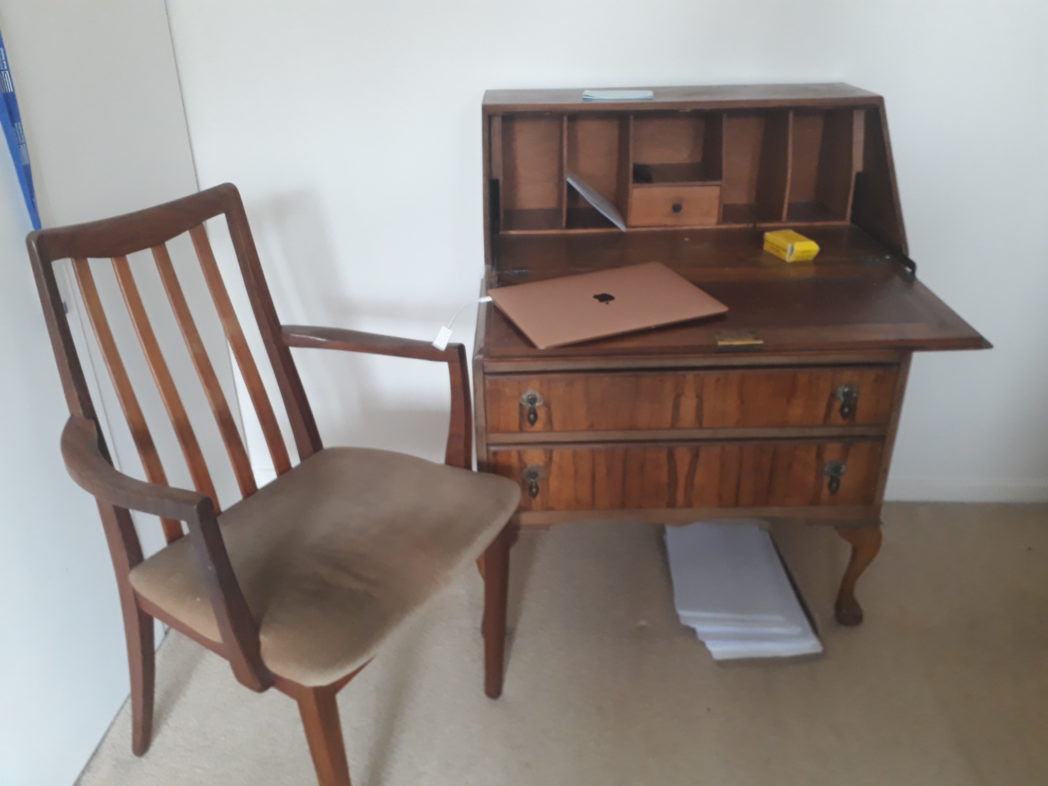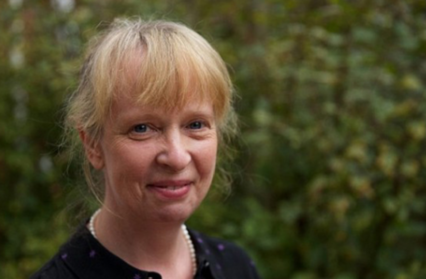In the latest in our series peeking into the creative spaces of Wales’s top writers, best-selling novelist Kate Hamer walks us around her writer’s room.

This is my permanent desk – the one I come to most days. It faces a blank white wall and that’s just the way I like it. It could sit on the other side of the room, looking out over trees but I prefer it this way. White space like white noise, nothing to grab at your attention. When I’m here I can stay inside my writing bubble, in the enclosed world I’m creating with no distractions. Often, I turn the wifi off and leave my phone downstairs.
It wasn’t always the case. For a long time I had no desk and that was fine too. Stephen King in his magnificent book On Writing (one of the few writing books I regularly recommend) believes that the only really important thing is to have a writing space where you can close the door. He wrote Carrie and Salem’s Lot on a typewriter in the laundry room of a trailer with a child’s desk balanced on his knees. No matter, he could close the door. Revisiting this section of On Writing again I was intrigued that he is also an advocate of ‘no view’ – something I hadn’t even remembered, and he recommends pulling the curtains unless you’re looking out on a blank wall.
Interesting he uses this analogy again when it comes to the process of writing. The first draft should be written with the door firmly closed, this time a metaphorical door where the world is only in the writer’s head and there is no one peeking through. Later, it’s time to metaphorically open that door and let a few trusted readers in. I can’t recommend this book highly enough. It’s so much about trusting your gut, your instinct and when writing that is so valuable to reflect on, particularly when you are first starting out with all the crisis of confidence that it can entail.
When I wrote The Girl in the Red Coat I didn’t have a desk of any kind. I tried to construct one using books and a plank to put in the corner of the bedroom which, with my technical abilities, was an absolute disaster and lasted five minutes. In the end I wrote it mostly sitting on the bed. Some of it was written in Cardiff Library. Now, I have an aversion to having a big, imposing desk, one with all the bells and whistles. We have more space now our children have flown the coop so there is a room where I can keep books and a desk but I still would hate to have something too serious. I’d feel overwhelmed by it, as if my duty in writing would be overseen by such a magnificent desk and found wanting. This is the desk I’ve had for a long time now. It came from Keepance Antiques in Grangetown, Cardiff for about thirty quid five years ago. The Doll Funeral was written on it. I began my latest novel Crushed on it and then I was gifted a magnificent modern oak desk that I was always banging my knees on. It was a beauty but it felt too monumental, too solid and golden and now has been moved on and I’m back to my little bureau with its fake nod to antiquity and fancy little Queen Anne legs and I’ll probably use it until the flap falls off (the yellow box is a mini pack of tarot cards that I use sometimes if a character is stuck. I pull out a random card and see what it has to tell me). Having said that I do think it’s sometimes useful to mix it up. To take your notepad or laptop and sit in a café, or a library, or on your bed and let the story come in a little differently for being in a different place.
If the desk does fall to pieces I won’t mind too much though. All I really need is the lovely blankness of a wall and I’m ready, and I know that’s something I’ll always be able to find anywhere I happen to be.
Kate Hamer’s latest novel, Crushed, is available now.
Kate Hamer’s Writers’ Room piece is a part of a Wales Arts Review series.












